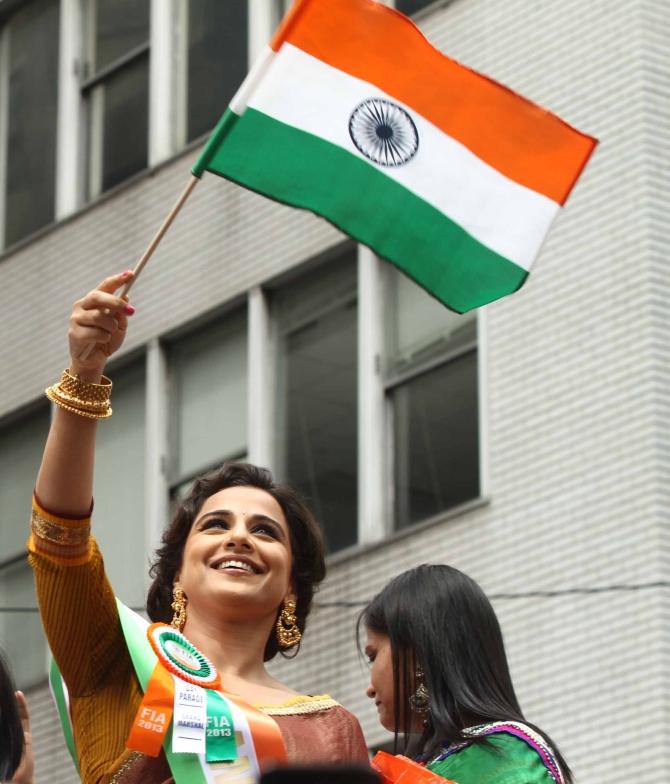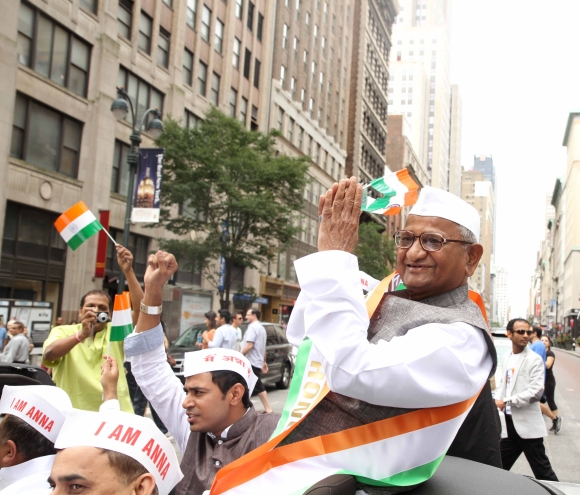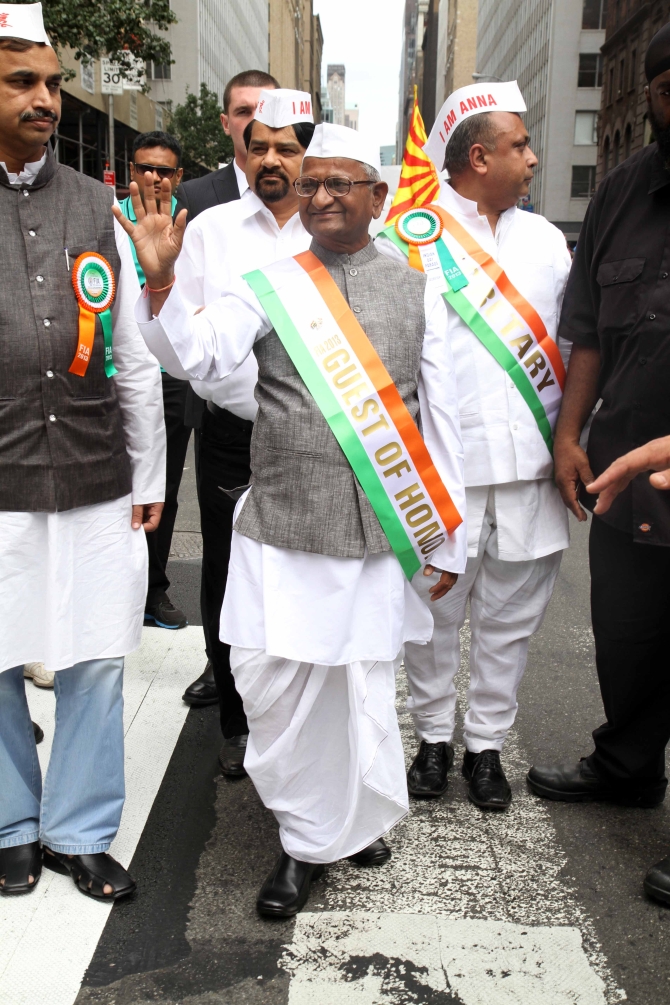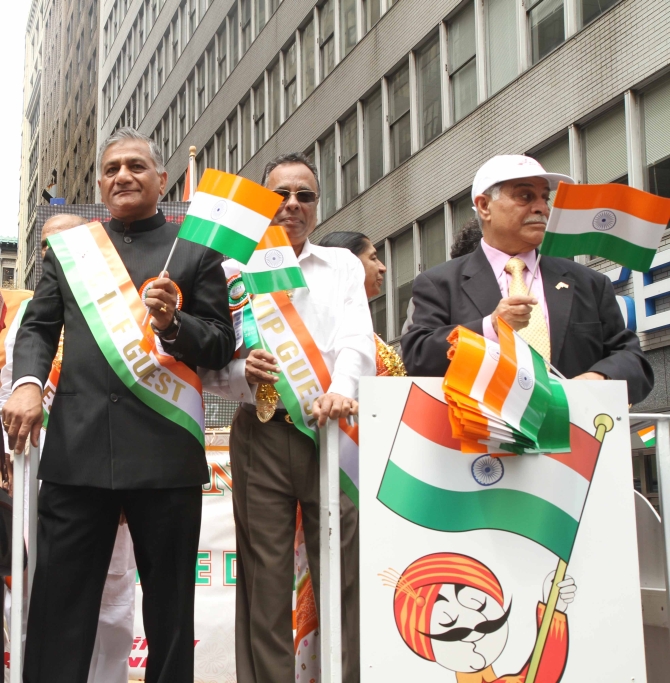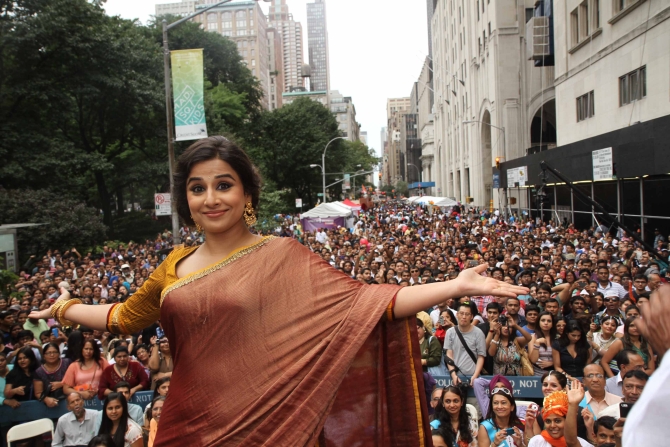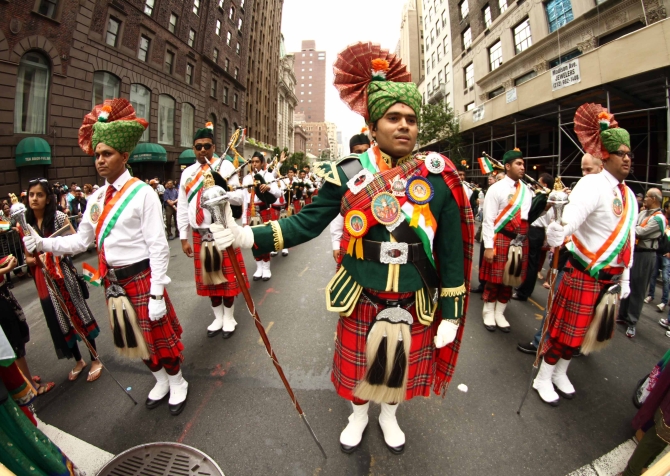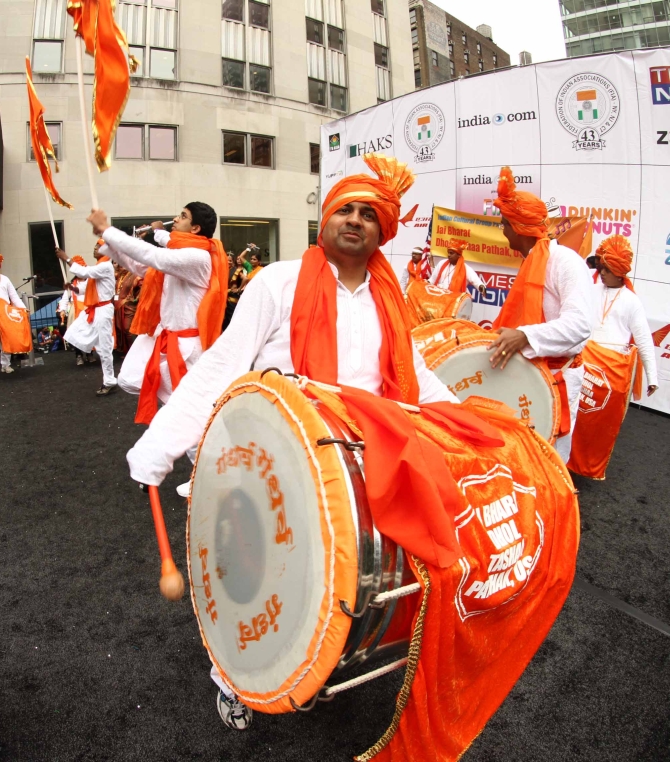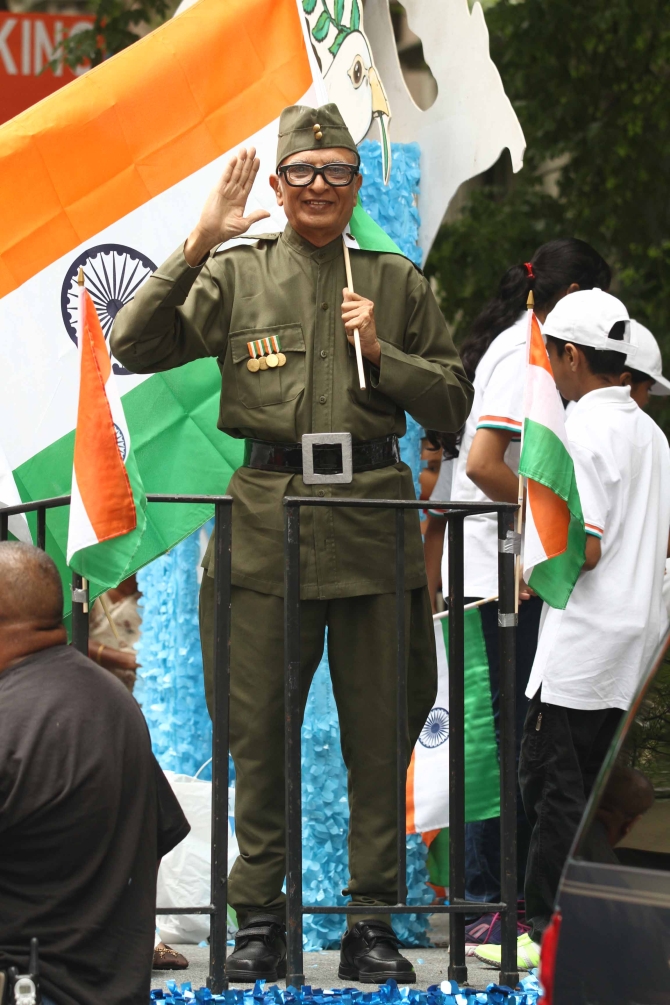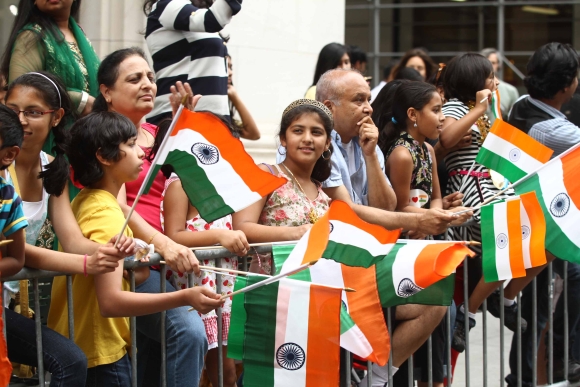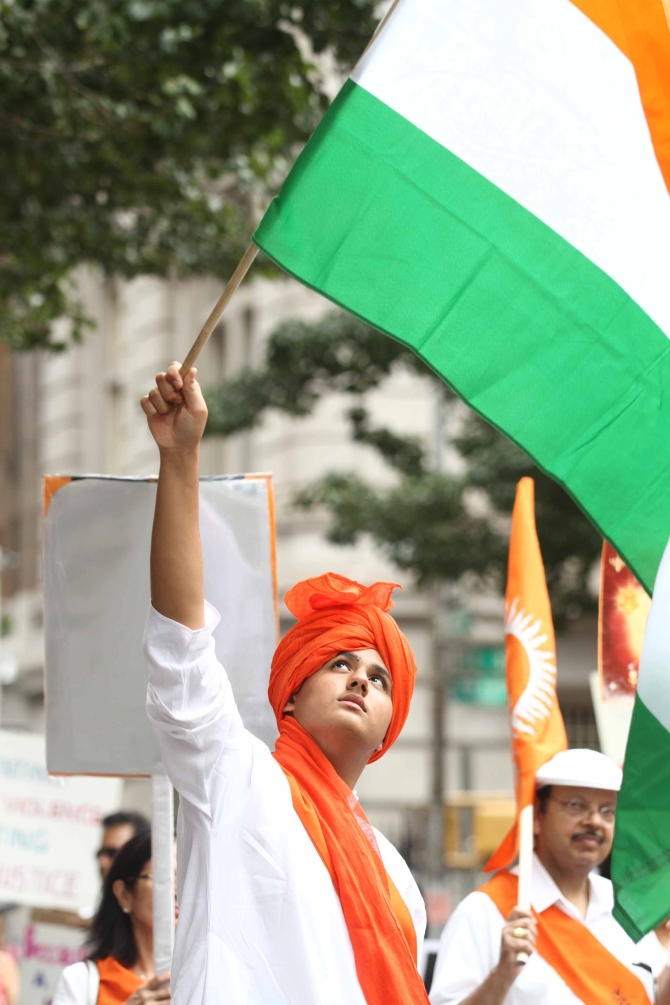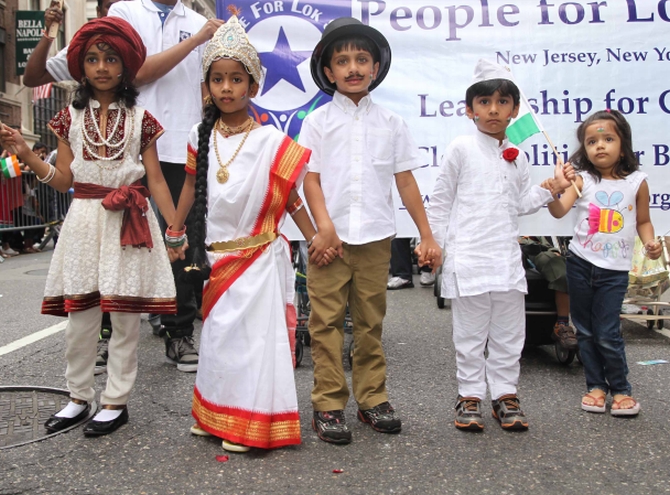 | « Back to article | Print this article |
'The melting pot that is India'
The India Day Parade in New York drew the masses, but where was the young second-generation? Rediff.com's Chaya Babu reports from the parade.
Photographs: Paresh Gandhi
The 33rd India Day Parade was my first. The thing I noticed immediately, and forgive me for being overly aware of myself, was that I seemed to be one of my own kind. I’m as Indian as anyone else I think, so let me explain.
I had heard that, after all these years, the parade has finally begun to attract a younger crowd of Indian Americans, those of my own generation, many born and raised around mostly non-Indians and now kind of grown up -- acclimated to more of an American identity in a lot of ways, but still Indian, of course.
However, with the thousands of people cramming the sidewalks, perched on the rounded tops of mailboxes, waving their Indian flags in their colorful garb, I still got the sense that the crowd was made up of predominantly older folks of the previous generation and newer immigrants and their small children.
Perhaps there were some not so new immigrants whose lives are still immersed in the strong Indian enclaves of New York and New Jersey.
Please click Next to read more
'The melting pot that is India'
In a way, I guess this shouldn’t have surprised me. I myself had never been previously compelled on my own to go despite having grown up nearby. And over the past week, leading up to the big Madison Avenue celebration, I talked to numerous second generation Indians who expressed that India’s Independence Day is not something they feel particularly connected to or inspired by.
Priyam Bhargava, this year’s Miss India USA, stopped for a moment to talk to me in the middle of 29th street. She was decked out in a cream and gold-flecked sari, a tiara resting atop her flowing black waves.
“I think it’s great, being born in India, but raised in the United States, it’s kind of bringing both words together for me,” she said. “And celebrating being Indian in New York City is a fantastic thing the community here is doing. I’m from the South, and we don’t usually get to do something like this on a grand scale."
"One of the floats shows a bridge between the Taj Mahal and the Empire State Building, and that’s exactly what this parade is doing: bridging two different worlds.”
Though her family came to America when she was only a year old and thus identifies as Indian American, Bhargava said something about being born in India gives her a greater sense of pride than maybe those born here. This rung true to me as I thought of others -- Rajul Punjabi, Sheel Mohnot, to name a few -- who said that the 4th of July feels more patriotic to them. Bhargava on the other hand said that August 15th is of equal significance to her.
Please click Next to read more
'The melting pot that is India'
Similarly, as I squeezed through the throngs of people, some holding Styrofoam plates with Samosas or other Indian snacks from the stalls on 25th and 26th streets, a white girl and her Egyptian friend, Peter, tell me that they stopped by to check out the fun of the parade.
The girl, Sari Ramachandran, is married to an Indian American. Her husband, however, had zero interest in seeing it himself. He was at band practice. Peter said he couldn’t get his other Indian friends to show up either.
The sea of black hair and brown skin obviously meant that patriotism and excitement for India and its Independence, and everything else that is wrapped up in commemorating August 15, is important to Indians of the tri-state area and beyond.
There was roaring and clapping and loud “Vande Mataram” chants near the review stands.
“Just like on St Patrick’s Day, everyone becomes Irish, on India’s Independence Day, everybodybecomes Indian!” Ravi Batra announced from the platform.
He was met with cheers and laughter.
Please click Next to read more
'The melting pot that is India'
Vidya Balan, this year’s Grand Marshall, sat in the back row quietly, only standing up to salute the crowd from time to time. She, along with 'Anna' Hazare and Chief Guest General V K Singh (retd), were the parade’s attractions.
I also glimpsed my parents’ friend, H K Chandrasekhar, with his tri-color striped sash, waving to the procession. A doctor who emigrated in the 1960s, he fit in among the prominent faces of the festivities.
Balan had been on the first float that came down Madison. General Singh was on the second, the Air India float. Hazare was third -- in a Ford Mustang.
Apart from that little standout, many of the floats looked alike, whether they were representing banks, religious institutions, or mobile and media companies.
Green, orange, and white streamers wrapped around the base of the floats; pretty young women did a repetitive circuit of dance moves to blaring Bollywood beats.
It was refreshing to see grassroots non-profits, like Sakhi for South Asian Women, holding signs and marching on foot.
Please click Next to read more
'The melting pot that is India'
A young woman from New Jersey, Aditi Dixit, with her five-year-old daughter Somya, were part of the Siddhi Vinayak float and had danced in front of it.
“Different parts of India had different floats,” said Dixit, who came to the US from Maharashtra ten years ago.
“We’re here to show that pride for our Independence Day, and also because Somya loves to see all this.”
There were many of Dixit’s sort -- young, more recent immigrants, some with their own new second-generation tots.
It was hard to find the other sort, but Mukul Arya in his slim-fitting grey suit caught my eye. Arya, 40, a New Yorker from birth and now raising his 4-year-old in Manhattan, happened to be hosting an event at Pranna on 28th and Madison. He was watching the parade simultaneously from just outside the restaurant.
Though he had attended multiple times in his younger years because a close friend’s father was an early member of the FIA, he slowly stopped coming as he got older. Not that surprising.
“After I had my daughter, I realised I wanted to come out and show support, show solidarity for the community, and also just get her involved and expose her to what it’s like being Indian today in New York as opposed to what it was like over 20 years ago. It’s very different,” he said.
“You see the presence of all places and cultures and creeds that are Indian, the melting pot that is India. You’ve got your Punjabis, Gujaratis, Malayalis, Tamils -- it’s a much more comprehensive representation of the Indian community now than it was back then. And this is a secular event; it’s not religious. India is a secular nation. This is symbolic of us as Indians. It unifies us.”
That’s true. I wonder if Arya’s daughter, a third generation Indian New Yorker, will pick up on this sentiment and value it.
I wonder if he has the power to shape that in her. I wonder if my Indian peers and I, most of us never having attended the parade or having known it exists, will come full circle and forge ties to India through our even more Americanized kids.
I guess only time will tell.
Please click Next to see more photographs from the event...
'The melting pot that is India'
Marching bands and procession of 40 floats depicting Indian culture add colour to the parade.
Please click Next to see more photographs from the event...
'The melting pot that is India'
Indian-Americans play the dhol as they participate in the 33rd edition of the parade.
Please click Next to see more photographs from the event...
'The melting pot that is India'
A patriotic desi joins the parade which saw the participation of thousands of Indian-Americans.
Please click Next to see more photographs from the event...
'The melting pot that is India'
Indian-Americans wave the tricolour as they witness the biggest I-Day celebration outside India.
Please click Next to see more photographs from the event...
'The melting pot that is India'
The celebration saw cultural shows, dance and music by local artists after the celebrities gathered at the review stand to wave to the cheering crowd.
Please click Next to see more photographs from the event...
'The melting pot that is India'
Children dressed up as figures from Indian history at the parade in New York.
'The melting pot that is India'
New York's finest stand guard during the parade.
TOP photo features of the week
Click on MORE to see another set of PHOTO features...
